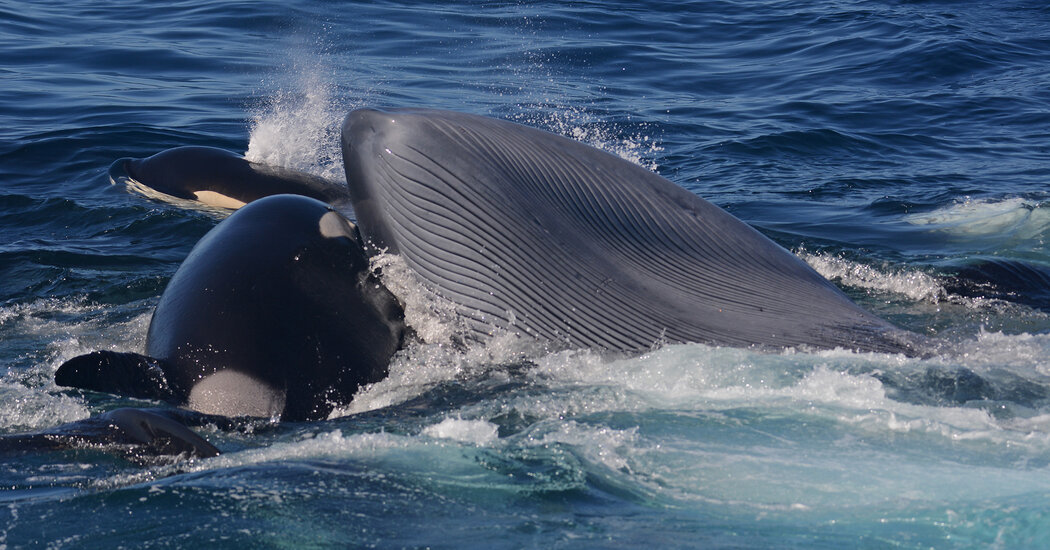Recordings in seas off Australia proved that the predatory prowess of killer whales is inescapable, even for the adults of the largest species that ever lived.
In March 2019, scientists studying whales near Southwestern Australia stumbled upon a supersize spectacle that few had seen before — a pod of orcas viciously attacking a blue whale.
Over a dozen orcas surrounded the mighty animal. They had already bitten off its dorsal fin, and the animal was unable to evade the fast and agile predators. The water ran red with the blood of the massive creature, and chunks of its flesh were floating all around. The scientists observed one orca force its way into the blue whale’s mouth and feast on its tongue. It took an hour for the orcas to kill the blue whale, and once they did, about 50 other orcas showed up to devour the carcass.
Orcas, also known as killer whales despite being members of the same family as dolphins, are apex predators who are known to feed on nearly every species of large whale. But, they typically go after calves and not adults. This was the first time that orcas had been observed successfully killing and eating an adult blue whale.
The attack was the first of three such events that were witnessed from 2019 through 2021. These events, described in a paper published last week in the journal Marine Mammal Science, have put to rest a longstanding debate among scientists about whether or not orcas could make a meal out of an adult blue whale.
A pod of orcas taking down a blue whale is “the biggest predation event on Earth, maybe the biggest one since dinosaurs were here,” said Robert Pitman, a marine ecologist at Oregon State University and an author of the paper.
Anecdotal evidence that orcas are capable of making a meal out of an adult blue whale has long existed, but it wasn’t until 2019 that scientists were able to confirm this through firsthand observation.
“Upon approach, we were astounded at what we were seeing,” said Rebecca Wellard, the founder and lead researcher at Project ORCA, who was among the researchers who witnessed the 2019 attack. “When you come across a unique event like this, I think it takes a while to process just what you are seeing.”
Blue whales, the largest creatures that have ever lived, can grow up to 110 feet in length, but the animal being attacked was only 70 feet long, which raised questions about whether it was a younger blue whale. But Dr. Wellard and her team were able to photograph the blue whale before the orcas tore it to shreds. Based on its appearance, as well as the location and time of year it was photographed, they concluded that it was an adult pygmy blue whale, a subspecies that is genetically similar to the most massive of the blue whales, but with a smaller size and other distinguishing characteristics.
Pygmy blue whales reach lengths of up to 79 feet, so this animal was most likely an adult.
“I think a full-grown pygmy blue whale could be mistaken for a regular blue whale that was not quite mature,” said Erich Hoyt, a research fellow with Whale and Dolphin Conservation and the author of “Orca: The Whale Called Killer.” He was not involved in the research.
Mr. Hoyt said that the fact that these orcas were able to successfully hunt this pygmy blue whale served as strong evidence that they could do the same to even the most massive blue whales. “Blue whales are fast, but orcas are faster,” he said.
The event that Dr. Wellard and her team witnessed took place off the coast of Bremer Bay, a biologically-rich region where large numbers of orcas, blue whales and other cetaceans can be seen during certain times of the year.
“The killer whales we research off Bremer Bay are rewriting the textbook on what we thought we knew about this species,” Dr. Wellard said.
Photographers aboard whale-watching boats in the region documented two other orca attacks on blue whales since the attack observed in 2019. Over a dozen orcas coordinated to carry out both attacks on juvenile blue whales. While scientists had observed orcas with dead blue whale calves in the past, such attacks had not yet been documented from start to finish.
Although the predation of blue whales by orcas is gruesome, scientists say it could be a positive sign for the health of whale species in the area. The whaling industry nearly drove blue whales into extinction, and the fact that enough of them now exist to be preyed on by orcas may hint at population growth.
“What we could be seeing now is a return to ‘normalcy’ as populations of large whales, and their predators, continue to recover,” Dr. Wellard said. “It may just have been a matter of time before an observation like this was made. Nonetheless, these hunts signal a positive step for both species’ populations.”


























